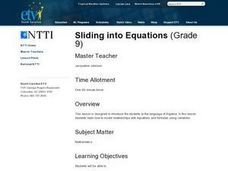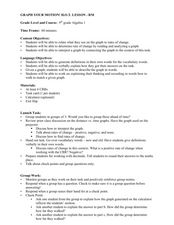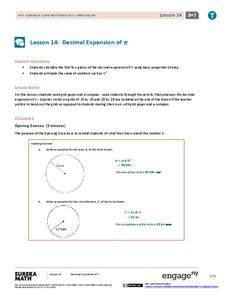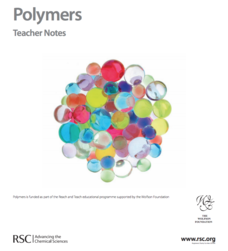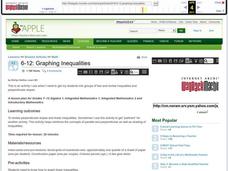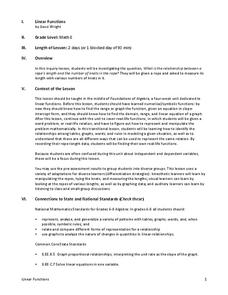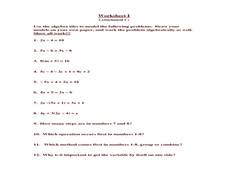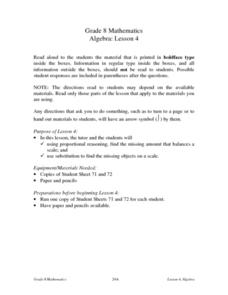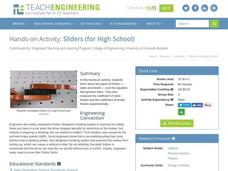Curated OER
Sliding into Equations
Ninth graders translate sentences into equations. They translate equations into sentences. They solve real life problems using verbal models to write equations. They create a problem solution graphic organizer in their journals.
Curated OER
Balancing Chemical Equations
Ninth graders explain how atoms and molecules form different substances during chemical reactions and how these processes require losing, gaining or sharing electrons. They correctly write chemical formulas and show how a balanced...
Curated OER
Double This
Learners change verbal expressions to algebraic equations. They practice the vocabulary of algebraic equations.
Curated OER
The UPS Experiment
Students calculate the speed using metric measurements. In this geometry lesson, students calculate speed, distance and velocity using metric measurements. They gain inquiry and problem solving skills in this assignment.
Curated OER
Graph Your Motion
Students graph their linear equations. In this algebra activity, students examine their lines and relate it to the slope or rate of change. They relate the steepness of the line to the slope being positive, negative or zero.
Curated OER
Pulleys and Gears
Students analyze an engineering problem. They contrast paper and pencil mastery of concepts with hands-on mastery. They present their design and rationale behind it, whether it works or not.
Curated OER
Test On Analytic Geometry/ Play Green Globs
High schoolers engage in a lesson that focuses on analytic geometry. The lesson asked them to apply skills of relating equations when plotting them on the coordinate plane. Students construct the equations using specific criteria and...
Curated OER
Five E Lesson Plans For Math
Students use the Five E method to solve problems. In this Five E lesson plan, students complete math lessons using the Engage, Explore, Explain, Elaborate, and Evaluate technique. They use the Five E's with lessons on tessellations,...
Curated OER
Graphing Systems of Inequalities
Solve equations and graph systems of inequalities. Designed as a lesson to reinforce these concepts, learners revisit shading and boundaries along with solving linear inequalities.
Curated OER
Does Order Really Matter?
Investigate the order of operations! Learners participate in interactive multi-media activities to examine and solve multi-step equations, inequalities. They evaluate formulas and simplify monomials and polynomials.
EngageNY
Decimal Expansion of Pi
Develop a better understanding of the value of pi. Learners explore the area of a circle using estimation and graph paper. While continuing to estimate the area of the circle using smaller and smaller grids, the number pi emerges.
Curated OER
Multiplication Mysteries
Arithmetic apprentices practice problem solving and multiplication with a lift-the-flap pair of reproducibles. In this Halloween mathematics lesson, math monsters practice multiplication by making candy corn calculations. They practice...
Teach Engineering
Discovering Relationships Between Side Length and Area
Consider the relationship between side length and area as an input-output function. Scholars create input-output tables for the area of squares to determine an equation in the first installment of a three-part unit. Ditto for the area of...
Royal Society of Chemistry
Polymers—Gifted and Talented Chemistry
Polymers are an important part of our day-to-day lives, but how much do your pupils know about them? Learn the basics and beyond in a series of activities designed to build skills in observation, planning, organic chemistry, and bonding.
Curated OER
Sorting Pennies, A Wagering Activity for Algebra I
Young scholars solve weight equations. For this equations lesson, groups of students weigh and separate pennies to find information necessary to solve simultaneous equations. The teacher provides equations based on the weight of pennies...
Curated OER
Graphing Inequalities
Students graph linear equations and then find the person in class whose linear equation graph is perpendicular to theirs. In this graphing inequalities lesson plan, students graph their perpendicular slopes and then once their find their...
Curated OER
Linear Functions
Students solve and graph linear equations. In this algebra activity, students collect data and plot it to create a linear function. They identify the domain and range of each line.
Institute of Electrical and Electronics Engineers
Get Connected with Ohm's Law
Ideal for your electricity unit, especially with middle schoolers, this lesson plan gets engineers using multimeters in electrical circuits to explore the relationships among voltage, current, and resistance. Older learners may even plot...
Curated OER
Left Hand, Right Hand - Solving Systems of Equations
Students compare the speed at which they write with their left hand to the speed at which they write with their right hand. The experiment serves as a vehicle to help students develop a conceptual understanding of the three different...
Curated OER
Let Algebra Tiles Solve Equations for You
Young scholars practice solving algebra equations utilizing model tiles. For this algebra lesson, students observe a clip from the movie Homeward Bound and break the action down into an algebraic equation. Young scholars...
Curated OER
Algebra: Lesson 4
Eighth graders participate in using algebraic proportional reasoning to find the missing amount that balances on a scale. Substitution is used to discover the missing objects on a scale. They answer multiple choice questions that are...
Teach Engineering
Sliders (for High School)
Slip sliding away. Groups investigates the two types of friction by running an experiment that allows them to calculate the coefficient of static friction and the coefficient of kinetic friction. The experiment uses a box, a...
Teach Engineering
Can You Resist This?
Some things are hard to resist. Small collaborative groups build circuits and calculate the voltage using Ohm's Law. Budding engineers explore the connection between the voltage across different resistors and linear...
Teach Engineering
Swinging Pendulum
Get into the swing of things. Pupils use a pendulum to demonstrate the conversion of potential energy to kinetic energy and back. After measuring the speed of a pendulum and compare it to the calculated theoretical speed, they...
